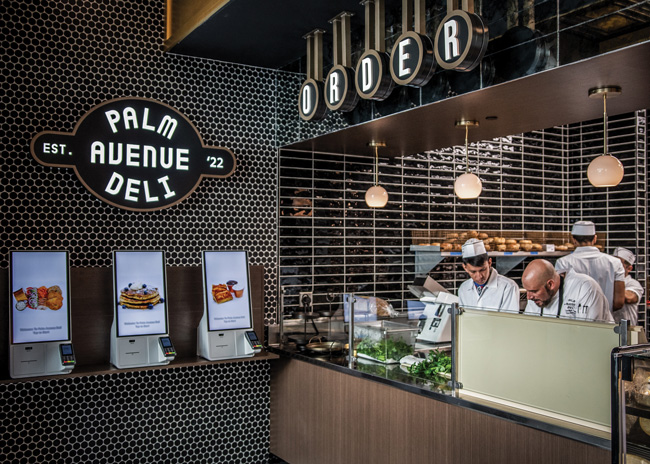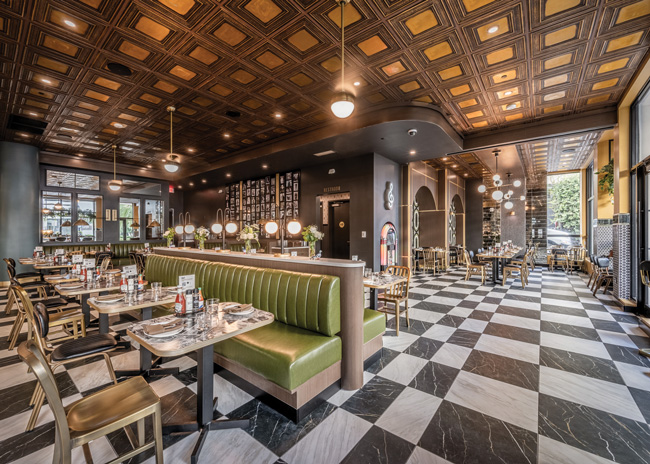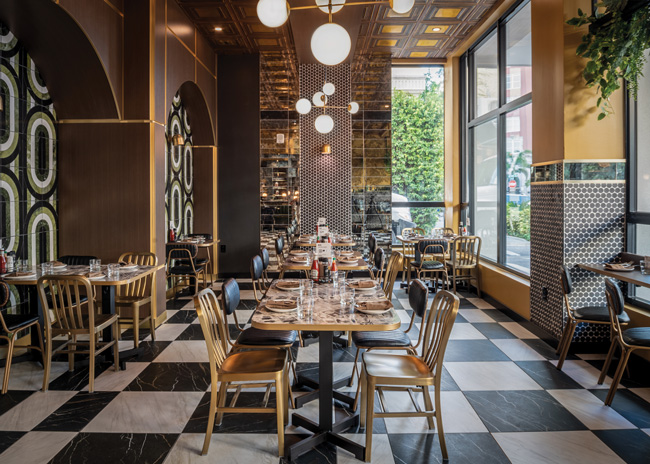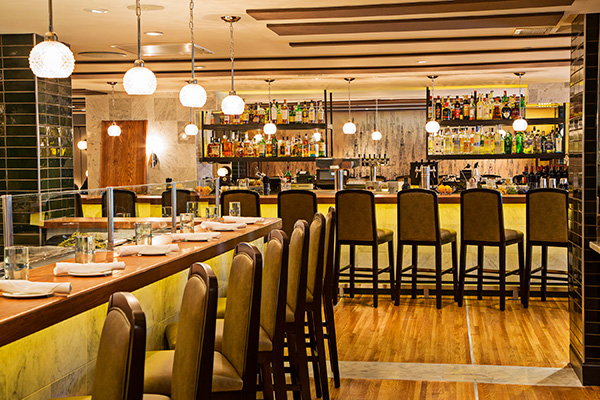 Images courtesy of Dylan Jon Wade Cox PhotographyWhen Tampa-based Hi Hospitality Group began concept development for its third restaurant on a single block of Palm Avenue in downtown Sarasota, Fla., they went back to their roots. Owners Mark and Natalia Levey, former New Yorkers with Jewish and Eastern European ancestry, respectively, relocated to Florida more than a decade ago and craved a taste of home — specifically in the form of the buzzy, traditional New York Jewish deli-diner. The result is Palm Avenue Deli.
Images courtesy of Dylan Jon Wade Cox PhotographyWhen Tampa-based Hi Hospitality Group began concept development for its third restaurant on a single block of Palm Avenue in downtown Sarasota, Fla., they went back to their roots. Owners Mark and Natalia Levey, former New Yorkers with Jewish and Eastern European ancestry, respectively, relocated to Florida more than a decade ago and craved a taste of home — specifically in the form of the buzzy, traditional New York Jewish deli-diner. The result is Palm Avenue Deli.
Opened in July 2023, it’s Hi Hospitality Group’s homage to both the authentic cuisine and the unique experience treasured by fans of classic New York delis. And it’s where Floridians, snowbirds and fellow transplants alike can now sip egg creams and nosh on bagels and lox, whitefish salad, pastrami on rye, potato latkes and other traditional and not-so-traditional specialties in a space designed to kick the whole experience up a notch or two.
Emphasizing the importance of sophisticated design to Palm Avenue Deli’s out-of-the-gate success, Hi Hospitality’s Director of Operations Robert Castellon — himself a New Jersey native — says the company’s goal was to create a truly immersive experience. “The style of this food is very sentimental for a lot of people. We have the ability as restaurateurs to provide great food, drinks and hospitality, but too often the idea of the immersive experience, of escapism when you walk into a restaurant, falls by the wayside,” Castellon says. “That’s contrary to our philosophy on opening restaurants. We really want that front door to be a kind of portal, for guests to feel like they’re being transported somewhere else. Palm Avenue Deli has a lot of strong visual components that we knew would help create that sort of transportive experience.”
Castellon, who managed the project for Hi Hospitality, worked with Easton, Pa.-based BLOK Design Group and Sarasota-based Solstice Planning & Architecture to achieve the deli’s desired look and feel. The aesthetic, he says, gives tip of the hat to New York institutions like Carnegie Deli and Katz’s without necessarily trying to replicate those experiences.
 “We wanted to ride the line between modernity and classic deli culture,” Castellon says. “In terms of aesthetic, we embraced a mid-century modern approach. That fit well, in part because the ’50s and ’60s was really the heyday era for those big New York delis and diners. But it also fit from a local standpoint, because Sarasota is well known for its mid-century modern architecture and design. Juxtaposing nostalgia with modern and a working-class-casual concept with some luxurious, refined design elements — with a few fun Easter eggs mixed in — really nailed the experience we were trying to create. It’s something that both older and younger demographics can relate to.”
“We wanted to ride the line between modernity and classic deli culture,” Castellon says. “In terms of aesthetic, we embraced a mid-century modern approach. That fit well, in part because the ’50s and ’60s was really the heyday era for those big New York delis and diners. But it also fit from a local standpoint, because Sarasota is well known for its mid-century modern architecture and design. Juxtaposing nostalgia with modern and a working-class-casual concept with some luxurious, refined design elements — with a few fun Easter eggs mixed in — really nailed the experience we were trying to create. It’s something that both older and younger demographics can relate to.”
The renovation project began with full demolition of what had been an upscale apartment building showroom to create a blank slate with which to work. Having not previously been operated as a restaurant, the space required a significant amount of MEP installation, notes Stephanie Muzzey, design director at BLOK Design Group. “There were a lot of mechanical issues in the building, just figuring out how to place exhaust chases, etc. And there were some supply chain delays related to getting equipment in,” she says. “Hi Hospitality was also in the process of opening an elevated tiki bar concept right next door at the same time, so there was a lot going on. But everything came together just as we envisioned.”
Old School, New School
Measuring roughly 2,900 square feet, Palm Avenue Deli’s interior layout is L-shaped and includes multiple guest experiences. A large, open kitchen along the restaurant’s left side — complete with culinary staff in nostalgic soda-jerk-style hats — adds concept authenticity and buzzy energy to the space. At the front end of the kitchen, just to the left of a host stand created from a Village Voice newspaper vending box, is a small retail area. There, guests can place takeout orders via large-screen self-order kiosks or pick up deli and bakery items to go.
 In the style of classic New York delis, Palm Avenue Deli includes a feature wall of framed celebrity photos.
In the style of classic New York delis, Palm Avenue Deli includes a feature wall of framed celebrity photos.
The front deli counter’s rounded corner also has a mobile-order pick-up tower. Clad in green tile, it’s designed as a front-of-house focal point and includes pass-through shelves from the kitchen for maximum operational efficiency.
“Mark Levey, one of the owners, has a technology background. He developed the software for the kiosks and POS system that’s in test at Palm Avenue Deli. He’s really passionate about marrying technology and design and guest experience,” notes Natalie Frey, principal designer at BLOK Design Group. “So, while the concept is very old-school-inspired, it is also very modern, incorporating new technologies to enhance functionality and efficiency.”
In front of the kitchen, a five-seat, diner-style counter gives guests a bird’s-eye view into the action. “We particularly like open kitchens for their aesthetic contribution,” Castellon says. “People really feel like they’re part of the action. We also take a lot of pride in our culinary execution, so inviting guests to be able to see everything being prepared, every step of the way, is very important to us.”
Additional counter seating runs along the front window wall facing busy Palm Avenue. For more traditional seating, the deli includes two dining areas. One at the front of the space holds loose tables and chairs and can be partitioned off for private parties via a curtain hidden in a ceiling soffit. The other, in the center of the restaurant and with views of the open kitchen, has diner-style booths and banquettes.
“Working with the architect, we all concluded early on that we wanted a certain style of seating, a style that fit New York,” Muzzey notes. “The mix is eclectic in terms of chair styles and it’s versatile. The restaurant has a lot of flexibility to be able to serve solo diners who come in with their laptops, small groups and larger parties equally well in what isn’t an especially large space.”
 Tabletops with music-related and vintage cartoon strip artwork, customized to include local Sarasota references, add to the fun period vibe.
Tabletops with music-related and vintage cartoon strip artwork, customized to include local Sarasota references, add to the fun period vibe.
And while many deli-diner concepts make low-brow design and rough-around-the-edges ambiance part of their charm, Palm Aveue Deli shines with rich finishes, custom features, saturated hues, stylish lighting and polished, tech-enhanced service.
“It’s so helpful when clients have a clear vision from the start, because then we as designers can take that vision, build upon it and make it come alive,” says Frey. “In this case, they wanted a New York vibe and mentioned the show "The Marvelous Mrs. Maisel" as inspiration. That helped us understand exactly the direction they wanted to go. They also brought some colors to us, such as rich green and dark teal, so we knew to include some of those muted tones. From there, we branched off to incorporate a lot of weathered brass, gold paint and black, just modernizing the look and giving it some Sarasota flair.”
Playing off classic New York deli-diner design elements, BLOK included a feature wall in the central dining area with a collection of framed, black-and-white photos of celebrities. The images, which over time will be replaced with color photos of celebrities who have visited Palm Avenue Deli, are presented above a row of booths in three large panels separated by gold trim and wall-mounted brass light fixtures. “We tried multiple versions of how we were going to display those photos,” Castellon notes. “But where we landed was just right. That wall really ties the room together nicely and it’s something you’d expect to see in a traditional New York deli.”
In the front dining area, a feature wall holds a vintage jukebox and two large, wood-framed arches that showcase custom, deco-style tile installations. For flooring, the designers went with an updated version of familiar black-and-white checkerboard, mixing 24-by-24-inch tiles with 12-by-24-inch tiles to create a nontraditional pattern. And while walls lined in white subway tile are common for the genre, Palm Avenue Deli’s luxe aesthetic is supported with sleek black subway tile behind the open kitchen and black, penny tile wallcovering in the front of house.
The restaurant’s ceiling, which looks like vintage tin tiles, has functional as well as aesthetic value. “Acoustics is a huge deal, especially in a space like this one where we have so many hard surfaces,” Frey says. “You’d never know it without looking really closely, but the entire ceiling is acoustic tile. It works wonders and we’ve had no issues with excessive noise.”
 The center area offers diner-style booth and banquette seating, while a dedicated mobile-order pick-up tower keeps to-go traffic separate.
The center area offers diner-style booth and banquette seating, while a dedicated mobile-order pick-up tower keeps to-go traffic separate.
Throughout the space, customization and special artistic design features add additional flair. Tabletops, for instance, are edged in brass banding and many feature vintage-style comic strip artwork. “The tabletops are really special,” Muzzey says. “The finish on them is super scratch- and stain-resistant. Touchpoints are a very big deal to us and our clients alike, and we splurged a bit on these. Originally, we had just placed old comics on the tops, but then we decided to customize them by changing up the wording in the strips to include some Sarasota lingo. That’s one of a few little Easter eggs sprinkled in to the design.”
Another is cards perched in holders on each dining table. Designed primarily to help integrate technology, every card has a QR code that guests can scan for menu information and to place their own orders and pay their bills, if they choose to. Rather than simply present the QR codes, however, the table cards also add to the Jewish deli vibe. Each presents the definition and humorous usage for a common Yiddish word, such as “kvetch: to complain, whine, or grumble in a persistent or annoying manner” followed by, “no kvetching, just scan or tap the QR code.”
Restrooms, too, received custom artistic treatment. There, Frey designed pop-art inspired wallpaper and framed art to keep the vintage vibe and immersive experience going. In one of the restrooms is a large, Andy Warhol-style print of Marilyn Monroe eating a pastrami sandwich; in the other, the featured art, in that same pop-art style, shows Elvis blowing a big bubble-gum bubble. “We really tried to draw inspiration from that whole time period and from the iconic cultural references to that era,” Frey says. “It all combines to create a fun and unique guest experience.”

Project Team
Ownership: Hi Hospitality Group, Tampa: Natalia and Mark Levey, owners; Robert Castellon, director of operations
Architect: Solstice Planning & Architecture, Sarasota, Fla.: Jonathan Parks, principal Window counter seats face downtown Sarasota’s busy Palm Avenue, the restaurant’s namesake.Interior design: BLOK Design Group, Easton, Pa.: Stephanie Muzzey, design director; Natalie Frey, principal designer
Window counter seats face downtown Sarasota’s busy Palm Avenue, the restaurant’s namesake.Interior design: BLOK Design Group, Easton, Pa.: Stephanie Muzzey, design director; Natalie Frey, principal designer
Millwork: Concept Design & Wood Works, Sarasota: Matthew Fisher
Foodservice consultant: SSA, Tampa: Ken Schwartz, president; David Hensel, executive vice president
Snapshot
Concept: Modern New York Jewish deli-diner
Location: Sarasota, Fla.
Opened: July 2023
Real estate: Urban storefront
Project type: Full renovation
Size: 2,900 square feet, 88 seats
Buildout: 2 years
Design highlights: Rich green, black and gold color scheme; mid-century-style lighting; extensive use of tile and mixed patterns; repurposed Village Voice newspaper box host stand; vintage jukebox; mixed seating styles; open kitchen with diner-style counter seating; large-format self-order kiosks; retail deli area; mobile-order pick-up tower with pass-through shelves; Yiddish-themed QR table cards; celebrity photo wall; custom pop-art restroom wallpaper and prints; custom vintage-style cartoon tabletops



